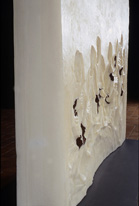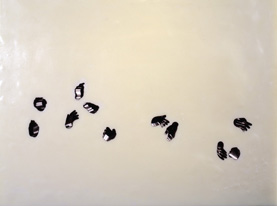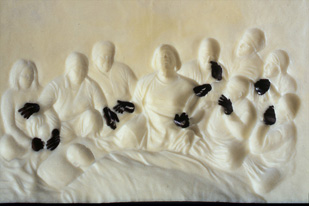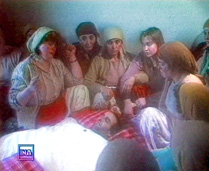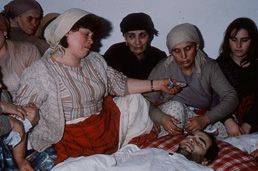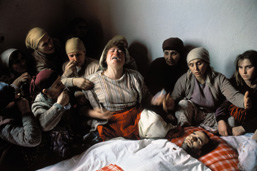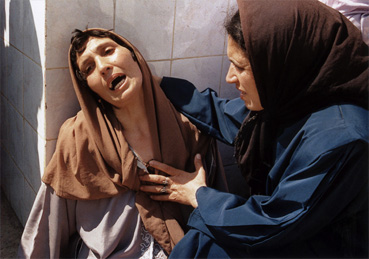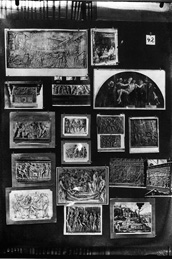Archéologie de l'architecture, de l'enfance, de l'histoire, du corps, des temps
1998 - 2005
Lamento
Lamento est un recueil de cinq textes tirés de l'ouvrage du même nom, édité par le Musée d'Art Moderne Grand-Duc Jean, (Mudam Luxembourg), à l'occasion de l'acquisition du Musée des trois sculptures de Pascal Convert autour de la question de la photographie de presse.
"Pascal Convert ou comment se dépêtrer du réel" / "Pascal Convert or how to get free of the real" /
"Pascal Convert oder wie man sich von der wirklichkeit befreit" Catherine Millet
"Images passages" / "Passageway images" / "Durchgangsbilder" Pascal Convert
"Eloge des aérolithes" / "In praise of aeroliths" / "Lobrede auf due himmelssteine" Philippe Dagen
"L'orphelinat des images" / "The orphanage of images" / "Das wisenhaus der bilder" Bernard Stiegler
"Constructing Duration"
by Georges Didi-Huberman
Duration is constructed constantly, all the time, within a certain relation between history and memory, present and desire. But this construction always comes up against the obstacles of habit. For example, we have watched the news on TV, as we do every day. We have seen, again, for the umpteenth time, those images of fire and blood, of war and human suffering.
But are they really even images? Are they not, rather, simple excerpts, in the sense that we speak of excerpts from a film, like clips of the historical suffering that they are supposed to document? And are they not, therefore, impossible to truly look at, that is to say, incapable of constructing something within a duration, edited as they are like commercials, crushed in a general levelling- out of blindness or cynicism? It's hard to say now - with the run-ofthe-mill fodder of the society of the spectacle, muted by media cant, drowned in the flux that bears them on, in the flux of cliches where we cheaply buy our simulacra of milestones and meanings?
A recent work by Pascal Convert, part of a more extensive ensemble based on a number of images of historical misfortunes, (1), A recent work by Pascal Convert [fig. 1-3, p. 241 part of a more extensive ensemble based on a number of images of historical misfortunes,offers a very different experience. We are no longer faced here with a screen on which we can zap as soon as boredom appears or anxiety raises its head, but instead with a kind of wall. Mass and obstacle: a white wall, inevitable. Slightly concave its surface strangely turbulent in places, it draws us to its curve, physically summons us, invites us to come closer; but then its opacity suddenly overhangs, blocks our way. As if to throw us off course by stopping our movement; to disorient us by stopping us in front of it.
The material this wall is made of is surprising: the movements that ripple across it at first bring to mind Donatello, but the object has none of the consistency of marble. It's more like alabaster, for the light penetrates to a certain depth and leaves something like a - magnificent - aura in the mass. We suddenly realise that this whole wall is made of white wax. We then come to understand that its "reliefs" are in fact hollows, white hollows with, here and there, forming constellations, a few dark holes indicating a different material. The visual experience becomes complex: here, the obstacle imposes itself, there, a hole encourages us to pass through the wall; here, light radiates from the interior, there, it adheres and even grazes the forms; here it accentuates, there it dissolves; here, the materiality is underscored, there, something intangible is created. From the outset, we fail to grasp the play of positive and negative, of the reliefs and hollows. And photographic reproductions only raise this ambiguity to its limit.
We are a long way from any photo (cliche). There is nothing in this mass that offers us an available sign, a recognisable extract, a clip or a spot of any kind. Language itself is deprived of its own cliches. Before this mass of silence, the signs of meaning are not provided in advance but must be built upon the moment of muteness that at first strikes us, takes us aback. We therefore rieed a little patience. We look, we wait, we question. All of a sudden, something unexpected surges forth, and we discover that this white quivering, rippling like a great drapery, is in reality a screaming image, an image that howls, that storms, protesting in front of us. All these waves of draped wax, all these hollows are simply the forms of screams and sorrows emanating from some ten female figures gathering around a body laid out before them, probably a corpse.
Admittedly, the omnipresence of negative forms makes figurative recognition difficult. But at the same time it is immediate. The reason is that all these figures of women are represented here in front of us on a human scale: their faces are more or less the same size as our own. The only difference being that each one forms a hollow matrix in which our own could almost fit or nestle. Now, this great swirl of holes on the white slab of the sculpture is what marks the whole scene's expressivity: what we have here are not only nine women lamenting a dead body - all of this rendered in negative - but a wailing wall, a whole compact with open cries, a wall in which everything becomes "gaping mouths", "madness" and "misfortune", to use Euripides' terms in The Bacchae(2). Wherever these women's hands move in gestures of affliction and grieving, Pascal Convert has chosen to radicalise his hollowing with a warren of orifices cutting through the slab, so that the back of the wall presents no more than a constellation of negative hands.
Using hollowness to sculpt the cry: Convert here is taking up position in an aesthetic debate with a very long history. Ignoring the ascetic strictures of Clement Greenberg in his Toward a New Laocoon(3) he does not renounce the figure, the referent, expression or even the most extreme pathos. He does not prohibit himself from sculpting those "gaping mouths" that Lessing proscribed in no uncertain terms in his Laocoon:
"Simply imagine Laocoon's mouth forced wide open, and then judge! Imagine him screaming, and then look! From a form which inspired pity because it possessed beauty and pain at the same time, it has now become an ugly, repulsive figure from which we gladly turn away. For the sight of pain provokes distress; however, the distress should be transformed, through beauty, into the tender feeling of pity. A wide open mouth is, in painting, and in sculpture, a hollow, which produce
the most shocking effect there can be, not to mention the repulsive appearance that it gives to the rest of the twisted, grimacing face."(4).
This stricture was particularly significant to Lessing in that it purported to lay out the intrinsic limits on any visual image with regard to temporality, to the duration of its referent: the image, wrote Lessing, represents only a "unique instant". "Now, in a passion, the moment of paroxysm is the one that benefits least from this privilege [afforded by the imagination of time]. Beyond that, there is nothing, and to present to sight the extreme degree is to tie imagination's wings"; the wounded warriors who cried out when as they fell in battle in Homer, wailing tragic mothers, the way the Greeks in general had of "being brave without ceasing to weep" - all this Lessing peremptorily confines to the powers of poetic writing alone (5). As for sculptures, all they can do is cast a veil over their scream. But this precept did not prevent a whole sculptural tradition - from Alexandrian antiquity to Donatello, from Guido Mazzoni and Niccolo dell' Arca to Bernini, from Franz Xaver Messerschmidt to Medardo Rosso - from "opening mouths". And, standing in front of this white wall with its strange, agitated - wrinkled, hollowed, pierced - surfaces, how can we ignore the impression that here Convert has managed to present the scream along with its own drapery, the anguished black hole along with its own modesty, that is to say, with its own whiteness?
Convert's blenching work is presented, in fact, as the interpretation of another image - an image that was not preconceived or produced as a work of art, but whose aim was to inform about an event, to make visible the blindingly obvious (an image): it is an image, in colour, taken by Georges Merillon, a photographer at the Gamma agency, in a village in Kosovo on 29 January 1990. The event occurred, then, nearly ten years before the "War of Kosovo'', which tore the region apart between March 1998 (the first massive attacks by the Serb forces in Drenica) and June 1999 (when the KFOR entered Kosovo from Macedonia and Albania, after the International Criminal Tribunal charged Slobodan Milosevic with war crimes, and NATO implemented Resolution 1244, instituting an international presence in Kosovo). All of which is to say that in those days nobody though there was any need to pay attention to the troubles pitting the unarmed ardour of young Kosovar nationalists against the Serb army.
When Georges Merillon saw the AFP report on these early demonstrations come in over the wire he set off for Pristina. He had no precise information, no translator. On his very first day there he witnessed clashes between young autonomists and the Serbian forces. "They were still throwing stones at tanks'', he later explained to Pascal Convert. (6). On the evening of his second day, he heard about a village where the army fired on demonstrators using real bullets. The following morning he travelled there with the Serb photographer Dusko Despotovic, Milos Cvetkovic and a small French television crew directed by Veronique Taveau. They reached the village of Nagafc at around noon. It felt, he recalls, like "the end of the world". (7)».
Merillon recalls how the villagers rushed to tell the newcomers about their suffering and anger. On 27 January the Serb police had literally set an ambush for a few youngsters from the village who were on their way to a gathering in Rahovec, a few kilometres away. They took up position at a bend and opened fire: four were killed, thirty-two wounded. The journalists were almost frog-marched to a small room where the body of a twenty-eight year old nationalist, Nasimi Elshani, was laid out. The women - the young man's mother, his sisters, his wife, his friends - were all there, huddled together around the body lying on the ground.
But time was short: because of the curfew they had to get back to Pristina as soon as they could. Veronique Taveau's team - three people - filmed the group of women. Dusko Despotovic used the brightness of the camera spotlight to take a few snapshots.
Georges Merillon did nothing. He knew that he had no more than five minutes in the room. Once the TV crew had left, it returned to the relative darkness of the ambient light. Merillon clearly remembers the very special quality of the luminosity around the body. He refuses to talk about the Stimmung, about the psychic intensity and extreme pathos of this moment of collective grief, but he does describe with surprising precision the luminous Atmosphiire of the room. The cold outside, combined with the effect of the mass of women huddled together inside, had, on this second day of mourning, formed on the window (and probably in the air itself) a mist that, as Merillon says, "softened" everything. It was in this paradoxical softness of the air that he took a few images of their inexorable grief. The 100 ASA film was boosted to 200; the exposure time was slow (a fifteenth or thirtieth of a second), the lens a 35 millimetre one.
One of these images (8) - whose framing varies little, anyway, since the exiguousness of the room made movement difficult - is something of a masterpiece. Unbeknownst to its author, of course - or at least, it was when he took it. At the time, he simply thought that he had photographed what the television team had shot on video, since the two media were supposed to bear witness to the same scene - the same bodies, the same space and the same time. In fact, thanks to the cameraman Daniel Levy, who was returning to Paris, Merillon's transparencies followed the same path as the videocassettes for the France 2 television news. Merillon only just had time to scribble down a caption for his photographic series: "Nogovac, Kosovo, Yugoslavia, 28 January 1990. Mourners at the deathbed of Elshani Nashim (27), who was killed during a protest against Yugoslavia's decision to abolish the autonomy of Kosovo."
The magazine Time, which had commissioned Merillon's report, did not use his photograph of the mourners. The image was. first published in the spring of 1990 by L'Express, then - as a double page, but in a context quite unrelated to the events in Kosovo - in Le Figaro magazine. Curiously enough, the first public figure to have taken the photograph seriously would seem to have been Frarn;,:ois Mitterrand, when commenting on his "journal of the year" for the magazine VSD at the end of 1990. In the margins of the photo, Mitterrand wrote two sentences, the first of which seems to insist on the transhistorical - and, primarily, aesthetic - dimension of the image, whereas the second unambiguously evokes the historical and political lesson that can be learnt from this image:
"How can one not think of a canvas by Mantegna or Rembrandt? Anger and sorrow always have the same face. One of the most serious problems facing Europe at this century's end is that of minorities. We must attend to it as soon as possible." (9)
In February the following year, at the height of the Gulf War, that Merillon was following, doing everything he could to circumvent the censorship imposed by the American army (10), the jury of the World Press Prize, chaired by Christian Caujolle, met in Amsterdam (11). Eleven thousand images by one thousand three hundred press photographers were under consideration. The upshot of the heated debates was the jury's agreement that they should distinguish an image rather than the event it was documenting. This was how, in spite of what, at the time, seemed its "small subject" (12)», Merillon's sumptuous photograph came to be chosen as "photograph of the year". Caujolle praised two aspects of this "exceptional image", both its aesthetic value- "reminiscent of Rembrandt" -and its political capacity to underscore the importance of the local event at Nagafc as a symptom of a "major and urgent problem for the future Europe". Sadly, history was to prove him right. (13).
This is how, with the help of fame, Merillon's image of mourning became the "Kosovo Pieta". Who was it, then, who substituted the original, factual caption with this iconographic and cultural, and even cultual, one. Merillon says that he has no idea. As for Caujolle, he has expressed the greatest caution about the use of a pictorial and religious vocabulary, the same as was used to rename a photography by Hocine - on which Convert has also worked - when the journalist Michel Guerrin titled it "The Madonna of Bentalha" (14). The danger with such vocabulary is of course that we may forget the information amidst all the compassion. Is there not the risk of satisfying pure affective drives (pathos, passivity) in order to avoid the political question as such (ethos, the possibility of action)? Is not our wish here, even unconsciously, to swap the patient process of historical understanding required by these events for the immediacy of empathy?
Furthermore, "Pieta" and "Madonna" refer directly to Christian iconography. And yet the realities documented by these two photographs, in Kosovo and in Algeria, belong to traged ies occurring in the Muslim world. Do we not colonise the suffering of the people of Nagafc and Bentalha by imposing on them a semantic grid in which Christ and the Madonna are the ultimate and explicit models? One can understand the urgency of the debate at a time and in places where Christianity and Islam seemed to be engaged in a direct confrontation of which Kosovo is exemplary, since there the Albanophone Kosovars, the great majority of them Muslim, were lined up against Serbs, who are generally Orthodox Christians. As one thing led to another, this debate went so far as to confront these photographs published in the Western press with the famous Koranic prohibition on representation - a rather hasty way, it must be said, of disqualifying the uncomfortable pathos of these "icons".
The problem is of course much more complex than can be understood from this overly general opposition. The first people to consider Merillon's image an important one were the women themselves - the Muslim women of the Elshani family: his Veillee funebre ("Wake") was hung on the wall of Nasimi's room and then circulated around the entire region. And when, on 12 April 1999, the Serbian army, with "Arkan's Tigers", a paramilitary militia, moved into the village ofNagafc, pillaged it and burned it to ashes, Aferdita, the younger sister of the dead man - we can see her on the right of the image, still an adolescent in 1990 (her hair is not covered, just had time to bury the photographs in the garden, as Merillon was to find out in June 1999 when he returned to the scene to look for survivors. (15).
The problem is complex because images imply a duration that goes well beyond the time that they represent or document. Once again, here, we will see how images function according to that temporal "dialectic" so tellingly described by Walter Benjamin, or according to that cultural tangle of"migrations" and "survivals" evoked by Aby Warburg. (16). In order to understand such images, therefore, we need to consider their destiny - in the sense, for example, that Freud spoke of a "destiny" of the drives, or in the sense meant by Georges Bataille when he affirmed, in his last lecture at the College de Sociologie in 1939, that, "Confronting us with destiny remains, in my eyes, the essential part of knowledge." (17)
But what is a destiny? It is what history produces beyond itself: it is what carries it towards a past that it no longer remembers and towards a future that it does not yet know.
Merillon's photograph, certainly, refers to a specific event, and must therefore be thought in relation to the turbulence of the history that it documents, fragmentarily (since it documents only a very short duration of the event, a fifteenth or thirtieth of a second). As for Convert's sculpture, it offers this image a future as a work that endows it with an extra density, materiality, monumentality and relief - even if this relief is negative, even if the material is wax and even if the density is holing and discolourment. Without a doubt, Convert's work and Merillon's image belong to different cultural loci; and yet they still exist in accordance with a shared epoch, and it is this epoch that we would need, first of all, to consider, via the two apparently very distinct regions formed by artworks and war photographs.
It will therefore be necessary - and here I am merely restating the credo of any self-respecting art historian - to locate this press photo and this work of art in their respective contexts: the history of conflict in the Balkans which was the source of the events at Nagafc, the history of wartime photojournalism in which Merillon is a participant, the history of contemporary art to which Convert's work belongs. But this, the time of history, tells us only about one aspect of things. Whereas what images such as these have the power to do is show us the effects of history beyond itself. Gilles Deleuze put this in his own, eloquent way: "It seems clear to me that the image is not in the present [ . . . ]The image itself is a set of temporal relations from which the present simply flows, either as a common multiple, or as the smallest denominator. Temporal relations are never seen in ordinary perception, but they exist in any image, providing it is creativ e. They make palpable and visible temporal relations that cannot be reduced to the present"(18).
These relations of time that cannot be reduced to the present- or, consequently, to the illusion of a perfect coincidence between the time of the image and that of the event or even of the age, from which it draws its very existence - appear only after interpretation, after what Freud called a "construction in analysis" (19) : a construction of meaning involuted in the analysis of its material, and that itself is meaningful only through a construction of duration.
The point is to put history "face to face with its destiny": to confront it with the past that concerns it but that it no longer remembers, and with the future into which it is headed but of which it as yet knows nothing. The point is to construct historicity in accordance with the memory and the desire that unconsciously bear it forth. Now, the art of this construction - of this knowledge - involves a certain kind of thinking and a certain practice of montage. This is what Aby Warburg undertook to implement, for his own purposes, in the final years of his life, when he created an atlas of images that, significantly, he did not call Clio but Mnemosyne (20).
One of the plates in this atlas, for which several preparatory versions were made, covers as its theme the expression of extreme suffering through the iconography - but also, implicitly, through the theoretical motif expounded by Lessing - of Laocoon (21). It needs to be understood in the light of the project that Warburg sketched out as early as 1889, namely, to understand Western representations of pathos, from Hellenistic Greece to Donatello and beyond, from an anthropological viewpoint that is diametrically opposed to the aesthetic canons of Winckelmann and Lessing (22). It is no coincidence that this plate is directly preceded by one of the many montages that the atlas contains of the paradigmatic figure of Ninfa This is an ensemble of images in which the motif of femininity comes dangerously close to violent, murderous negativity (23). The plate that follows quite logically closes this kind of dialectics: it is devoted to the motifs of the corpse laid on the ground, of mourning and of lamentation (24).
From pagan Bacchants to Christian weepers, via the Jewish kinah or the Muslim complaint, what Warburg adumbrates in the plates of his atlas is the essentially tragic motif of a Ninfa dolorosa . Logically, then, to put Georges Merillon's photograph and Pascal Convert's sculpture "face to face with their des tiny" would thus mean reassembling a huge atlas of lamentations in which would be sketched out the formal relations, circulation over time and anthropological power of these images. This destiny extends between antiquity and modernity with, no doubt, as a historical turning point, the crucial images invented by Donatello in the fifteenth century to figure what pathos and the expression of suffering are "saying", in the excess of all rhetoric.
In his short and remarkable article on the cinema of Guy Debord, Giorgio Agamben insisted on the "eminently historical character" of the image. He recognises that "Aby Warburg's project" provides the means to understand what it is that makes this history something more than a simple chronology. (25). From Warburg's Bilderatlas to Godard or Debord - we would need, at the very leas t, to add Chris Marker to this lineage, not to mention, for the 1930s, Eisenstein and Bataille in Documents-, it is indeed montage that constitutes the paradigm of any construction (whether its aim is epistemic or aesthetic makes no difference in this sense): in both cases "construction in analysis" goes hand in hand with construction in form). Now, the fundamental conditions of possibility of montage - its "transcendentals", writes Agamben - are known to be repetition and stoppage.
Repetition, as Nietzsche, Freud and Deleuze have brought home to us, "restores the possibility of what has been, makes it possible once again. H erein lies the proximity of repetition and memory. For memory cannot res tore to us what was as it was. That would be hell. Memory res tores the past's possibility. (It] is, so to speak, the organ of the modalisation of the real" (26). Light is shed on interruption (stoppage) as much by the " revolutionary interruption" theorised by Walter Benjamin as by the "caesura" recognised by Holderlin as the deep respiration of the poem (27). But it should not be said that the caesura "stops the rhythm" by interrupting the flow of words and representations (28). It should, on the contrary, be said that it constitutes as rhythm the relation thus es tablished between repetition and its cessations or differences. Montage is rhythm. In this sense it is capable of providing the phrasing of history that Jacques Ranciere has so eloquently discussed in relation, what's more, to the films of Godard (29). On one side, it complexifies, renders obscure the visibility of things (30);on the other, it musicalises things, that is to say, reveals their most "dynamographic" secrets (31) ».
"The image as such", writes Giorgio Agamben - in which he follows one of the fundamental theoretical principles of The Society of the Spectacle - is but a "zone of the undecidability between the true and the false"(32). This proposition goes hand in hand with a radical critique of press and television images: "The med ia always give us the event, what happened , without its possibility; they therefore give us a fact in relation to which we are powerless. The media love their citizens indignant but powerless. That is even the aim of the television news. It is bad memory, the kind that produces the man of resentment" (33). This diagnosis is accurate only to a certain degree of generality. Pascal Convert, who knows the intimate technological and ideological workings of television images and generally shares this political pessimism (34), has nevertheless spent a considerable amount of time - what better homage is there than giving time? - on press images that are, according to him, capable of opening our gaze to their own "possibilities," and therefore of producing that "good memory" evoked by Agamben. How can this be done, if not by refusing any kind of generality and constructing duration by a regulated montage of singular images taken up in the great rhizome of their relations.
Georges Didi-Huberman
1 Ce travail comporte trois sculptures monumentales présentées ensemble dans la collection du Musée d'Art Moderne Grand-Duc Jean (Mudam Luxembourg). L'œuvre dont nous parlons date de 1999-2000. Elle est en cire, résine et cuivre. Ses dimensions sont de 224 x 278 x 40 cm. L'artiste l'a intitulée: Pietà du Kosovo (inspirée de Veillée funèbre au Kosovo, photographie de Georges Mérillon, 1990).
2 Euripide, Les Bacchantes, trad. J. et M. Bollack, Paris, Minuit, 2005, p.27.
3 C. Greenberg, « Towards a Newer Laocoon » (1940), The Collected Essays and Criticism, 1. Perceptions and Judgments, 1939-1944, éd. J. Q'Brian, Chicago-Londres, The University of Chicago Press, 1986, p. 23-38.
4 G. E. Lessing, Laocoon (1766), trad. A. Courtin (1866) revue par J. Bialostocka, Paris, Hermann, 1990, p.45.
5 Ibid., p. 45-46 et 55-56. Sur le contexte philosophique de ce débat, cf. S. Richter, Laocoon's Body and the Aesthetics of Pain: Winckelmann, Lessing, Herder, Moritz, Goethe, Detroit, Wayne State University Press, 1992.
6 P. Convert, Entretien avec Georges Mérillon, 2003 (document vidéographique).
7 Ibid.
8 Georges Mérillon se souvient avoir réalisé une pellicule entière. Mais il ne lui reste aujourd'hui que cinq autres images de la scène: quatre d'entre elles sont prises d'un angle un peu biaisé, la dernière est cadrée verticalement. Quant aux rushes de Véronique Taveau, ils sont, en toute logique télévisuelle, définitivement perdus.
9 F. Mitterrand, « 23 (sic) janvier 1990. Le Kosovo pleure ses morts ", VSD, nO 694, 20-26 décembre 1990 "Numéro collection. 1990: Le journal de l'année par François Mitterrand" p. 40-41.
10 Les trois principales agences photographiques françaises - Sygma, Gamma et Sipa - ayant écartées du pool américain quelques photographes audacieux, dont Mérillon, se sont associés sous le label humoristique FTP (pour Fuck The Pool) et ont tenté, à leurs risques et périls, de tirer des images non officielles de cette guerre très contrôlée. Cf. M. Guerrin, « Les francs-tireurs de la photo face à la censure ", Le Monde, 20 février 1991, p. 5.
11 - Le Jury composé de dix membres: Christian Caujolle (président), Zevi Ghivelder (Brésil), David Goldblatt (Afrique du Sud), Vincent Mentzel (Pays-Bas), Randy Miller (USA), Daniela Mrazkova (Tchécoslovaquie), Kasumiko Murakami (Japon), Raghu Rai (Inde), Ruud Taal (secrétaire) et Vladimir Vyatkin (URSS).
12 G. Mérillon, « I Like to Capture Strong Emotions », World Press Photo Newsletter, juillet 1991, p. 2
13 C. Caujolle, « The Paradox of Contemporary Press Photography », ibid., p. 4. Id., « Foreword », World Press Photo 1991, La Haye-Londres, World Press Photo Holland Foundation Thames and Hudson, 1991, p. 5
14 P. Convert, Entretien avec Christian Caujolle, 2003 (document vidéographique). Cf. M. Guerrin, « Une Madone en enfer », Le Monde, 26 septembre 1997, p. 12
15 G. Mérillon, Texte inédit (1999) utilisé partiellement dans «Tout le martyr kosovar dans l'histoire d'une famille», Paris Match, nO 2615,8 juillet 1999, p. 24-29. Cf. également A. Cojean, «Retour sur images: le martyr du Kosovo», Le Monde, 28 août 1997, p.11
16 Cf. G. Didi-Huberman, Devant le temps. Histoire de l'art et anachronisme des images, Paris, Minuit, 2000, p. 85-155.1d., L'lmage survivante. Histoire de l'art et temps des jantômes selon Aby Warburg, Paris, Minuit, 2002
17 G. Bataille, « Collège de sociologie» (1939), Œuvres complètes, II, Paris, Gallimard, 1970, p. 365.
18 G. Deleuze, «Le cerveau, c'est l'écran» (1986), Deux Régimes de fous. Textes et entretiens, 1975-1995, éd. D. Lapoujade, Paris, Minuit, 2003, p. 270.
19 S. Freud, «Constructions dans l'analyse» (1937), trad. collective dirigée par J. Laplanche, Résultats, idées, problèmes, II. 1921-1938, Paris, PUF, 1985, p. 269-281.
20 A. Warburg, Gesammelte Schrifien, 11-1. Der Bilderatlas Mnemosyne, éd. M. Warnke et C. Brink, Berlin, Akademie Verlag, 2003 (2e édition corrigée).
21 Ibid., p. 74-75, planche 41a: «Pathos de la douleur. Mort du prêtre» (Leidenspathos. Tod des Priesters).
22 Id., Entwuif zu einer Kritik des Laokoons an Hand der Kunst des Quattrocento in Florenz «< Esquisse d'une critique du Laocoon à la lumière de l'art florentin du Quattrocento ») (1889), Londres, Warburg Institute Archive, III, 33.2.4.
23 Id., Gesammelte Schrijien, II-1. Der Bilderatlas Mnemosyne, op. cit., p. 72-73, planche 41 : « Pathos de l'anéantissement. Sacrifice. La nymphe comme sorcière. Libération du pathos» (Vernichtungspathos. Opfer. Nympha ais Hexe. Freiwerden des Pathos).
24 Ibid., p. 76-77, planche 42: « Pathos de la douleur dans son inversion énergétique (Penthée, Ménade à la croix). Plainte funèbre, héroïsée. Cantiques de lamentation. Mort du Rédempteur. Mise au tombeau. Méditation funèbre (Leidenspathos in energetischer Inversion [Pentheus, Manade am Kreuz). Bürgerliche Totenklage, heroisiert. Kirchl. Totenklage. Tod des Erlosers. Grablegung. Todesmeditation).
25 G. Agamben, «Le cinéma de Guy Debord» (1995), Image et mémoire. Écrits sur l'image, la danse et le cinéma, Paris, Desclée de Brouwer, 2004, p. 88-89.
26 Ibid., p.91.
27 Ibid., p. 92-93.
28 Ibid., p. 93.
29 J. Rancière, «La phrase, l'image, l'histoire» (2002), Le Destin des images, Paris, La Fabrique, 2003, p.41-78.
30 Cf. P. A. Sitney, Modernist Montage: The Obscurity of Vision in Cinema and Literature, New York, Columbia University Press, 1990.
31 Cf. G. Didi-Huberman, L'Image survivante, op. cit., p. 169-190 et 452505.
32 G. Agamben, « Le cinéma de Guy Debord », art.cil., p. 95.
33 Ibid., p. 91-92.
34 CE P. Convert, « Des images en mercure liquide », art press, nO 251, 1999, p. 39-49. Id., « Des images figées», ibid., nO hors-série, 2001 ( Représenter l'horreur ), p. 4047. Id., «Une distance aux choses. Entretien avec Raymond Depardon », ibid., nO 273, 2001, p. 29-35. Id., « Images passages », ibid., nO spécial 25, 2004 « Images et religions du livre»), p. 90-95.
/ Accueil /
Biographie / Oeuvres / Expositions / Films / Thématiques / Documents
Textes - articles / Editions / Liens - contact / Au hazard

